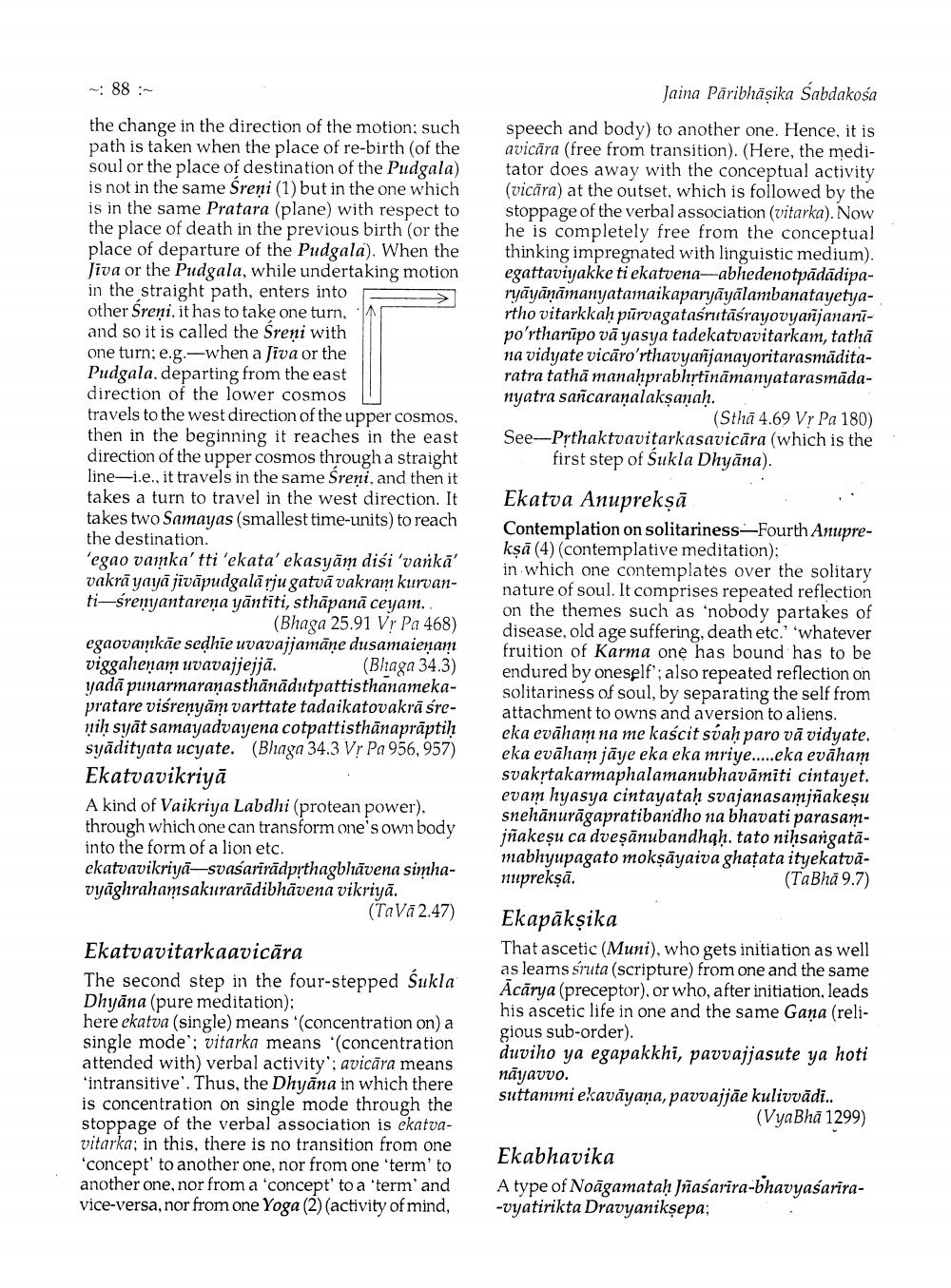________________
w: 88:
Jaina Pāribhāșika Sabdakośa
speech and body) to another one. Hence, it is avicāra (free from transition). (Here, the meditator does away with the conceptual activity (vicara) at the outset, which is followed by the stoppage of the verbal association (vitarka). Now he is completely free from the conceptual thinking impregnated with linguistic medium). egattaviyakke ti ekatvena---abhedenotpādādiparyāyāņāmanyatamaikaparyāyālambanatayetyartho vitarkkah pūrvagatašrutāsrayovyanjanaripo'rtharūpo vā yasya tadekatvavitarkam, tathā na vidyate vicāro'rthavyañjanayoritarasmäditaratra tathā manahprabhịtināmanyatarasmādanyatra sancaranalakṣaṇaḥ.
(Stha 4.69 Vr Pa 180) See-Prthaktvavitarkasavicāra (which is the
first step of Sukla Dhyāna).
the change in the direction of the motion, such path is taken when the place of re-birth (of the soul or the place of destination of the Pudgala) is not in the same Sreni (1) but in the one which is in the same Pratara (plane) with respect to the place of death in the previous birth (or the place of departure of the Pudgala). When the Jiva or the Pudgala, while undertaking motion in the straight path, enters into other Sreņi, it has to take one turn, and so it is called the Sreni with one turn; e.g.-when a Jiva or the Pudgala, departing from the east direction of the lower cosmos travels to the west direction of the upper cosmos, then in the beginning it reaches in the east direction of the upper cosmos through a straight line-i.e., it travels in the same Sreni, and then it takes a turn to travel in the west direction. It takes two Samayas (smallest time-units) to reach the destination 'egao vamka' tti 'ekata' ekasyām disi 'varkā' vakrā yayā jīvāpudgalā rju gatvā vakram kurvanti-śrenyantarena yāntīti, sthāpanā ceyam..
(Bhaga 25.91 Vr Pa 468) egaovamkāe sedhie uvavajjamāne dusamaienam viggahenam uvavajjejjā. (Blaga 34.3) yadā punarmaraṇasthānādutpattisthanamekapratare visrenyām varttate tadaikatovakrā śrenih syāt samayadvayena cotpattisthānaprāptih syādityata ucyate. (Bhaga 34.3 Vr Pa 956, 957) Ekatvavikriyā A kind of Vaikriya Labdhi (protean power), through which one can transform one's own body into the form of a lion etc. ekatvavikriyā—svasarīrādprthagblrävena simhavyāghrahamsakurarādibhāvena vikriya.
(Tavā 2.47)
Ekatva Anuprekṣā Contemplation on solitariness-Fourth Anuprekşā (4) (contemplative meditation); in which one contemplates over the solitary nature of soul. It comprises repeated reflection on the themes such as 'nobody partakes of disease, old age suffering, death etc.' 'whatever fruition of Karma one has bound has to be endured by oneself'; also repeated reflection on solitariness of soul, by separating the self from attachment to owns and aversion to aliens. eka evāham na me kaścit svah paro vā vidyate. eka evāham jāye eka eka mriye.....eka evāham svakytakarmaphalamanubhavāmiti cintayet. evam hyasya cintayataḥ svajanasamjñakesu snehānurāgapratibandho na bhavati parasamjñakeșu ca dveşānubandhaḥ, tato niḥsangatāmabhyupagato mokṣāyaiva ghațata ityekatvānuprekşā.
(TaBhā 9.7)
Ekatvavitarkaavicāra The second step in the four-stepped śukla Dhyāna (pure meditation); here ekatva (single) means '(concentration on) a single mode'; vitarka means '(concentration attended with) verbal activity'; avicāra means 'intransitive'. Thus, the Dhyāna in which there is concentration on single mode through the stoppage of the verbal association is ekatvavitarka; in this, there is no transition from one 'concept' to another one, nor from one 'term' to another one, nor from a 'concept' to a 'term' and vice-versa, nor from one Yoga (2) (activity of mind,
Ekapākşika That ascetic (Muni), who gets initiation as well as learns sruta (scripture) from one and the same Ācārya (preceptor), or who, after initiation, leads his ascetic life in one and the same Gana (religious sub-order). duviho ya egapakkhi, pavvajjasute ya hoti nāyavvo. suttammi ekavāyana, pavvajjāe kulivvādi..
(VyaBhā 1299)
Ekabhavika A type of Noāgamataḥ Jñaśarira-bhavyasarira-vyatirikta Dravyanikṣepa;




